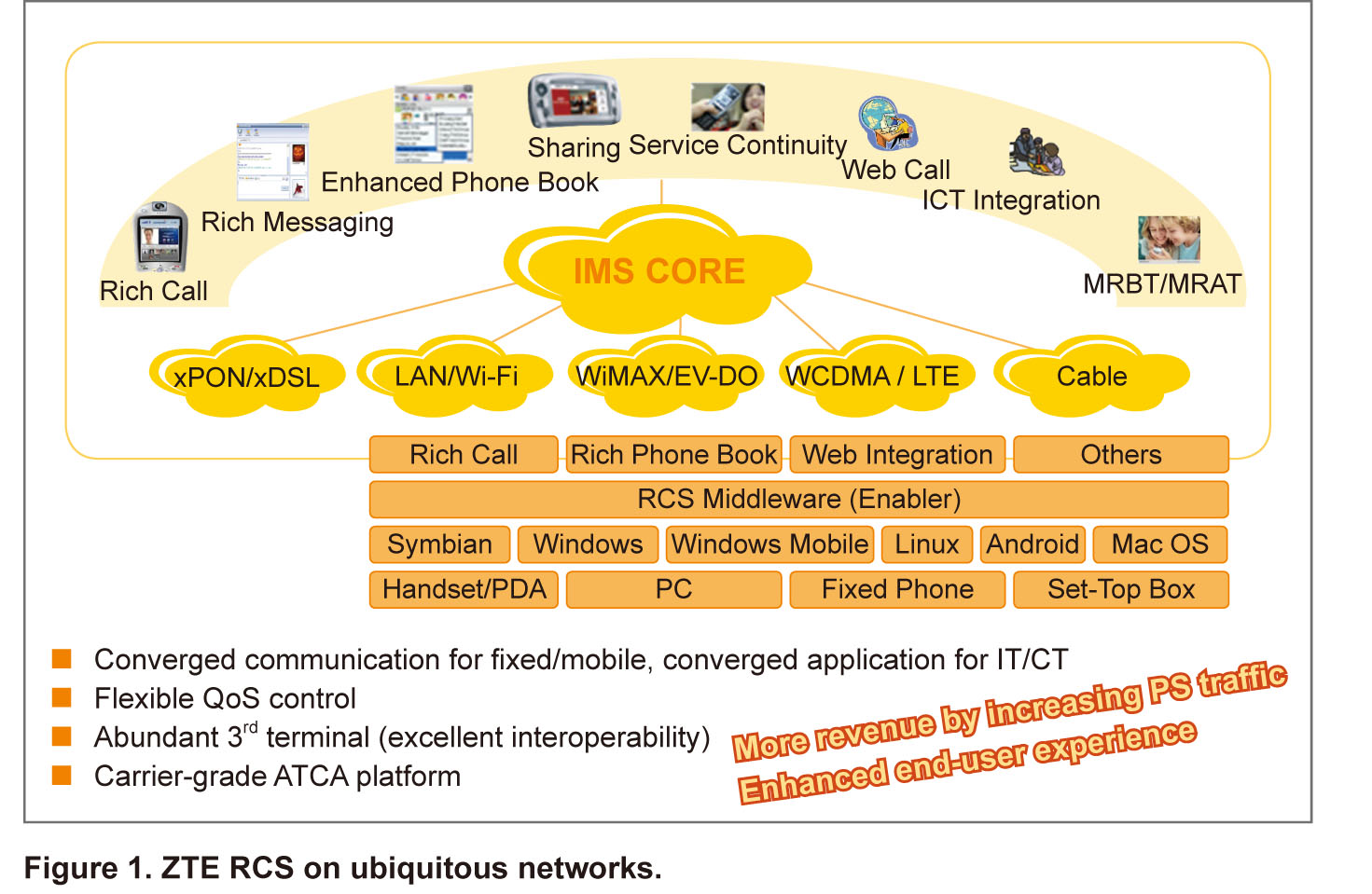Rich Communication Suites: A Significant Convergence Initiative
RCS: Not Just a Standard or Set of Services
IIt is perhaps easier to define RCS by what it is not rather than by what it is. RCS is not a formal or technical standard, but is more commonly referred to as an “initiative” or “industry effort.” According to the GSMA’s RCS initiative, it is neither a set of applications nor a set of services, but a framework for enabling services. Furthermore, although the RCS framework is managed in a similar way to a standard, it is based on existing standards and specifications. In the case of Presence, for example, it uses the framework of OMA Presence SIMPLE 1.1. RCS is closely bound up with the IMS architecture, and is sometimes offered as a partial answer to the question “what is IMS good for?” For ZTE—particularly in relation to its IMS—RCS is intended to be a set of defined IMS-based services which mobile operators can implement in a common way, thereby making interoperability easier between them and between the technological components of different vendors.
RCS: Direct Benefits for End Users
RCS is important because it represents an attempt to bring features and functionalities offered in the IP world into mobile telecom services. As such, it is more significant in enhancing the end-user experience than all access-oriented convergence initiatives.
From the end-user’s perspective, RCS Release 1.0 provides three services:
■ Enhanced phonebook: enables users to see the presence status of people in their normal mobile contacts list, and the available methods to contact them.
■ Enhanced messaging: adds IM functionality and conversational models to existing mobile messaging capability.
■ Enriched call: allows sharing of multimedia content during a call, including sharing of video files and real sightseeing.
RCS Release 2.0 (already being discussed although not yet completed) will add a PC client to allow PC-to-mobile and perhaps even PC-to-PC communications. Whether this will require a SIM card to be physically attached to the PC, as in the model used by existing services Unik and Outsmart’s Plug‘n’Talk , is yet to be decided.
RCS: Emphasis on Operators’ Key Assets
The greatest concern for operators about RCS is that efforts to encourage the take-up of mobile data services through attractive tariffs could have a negative impact on mobile voice revenues. However, at present there seems little to worry about. The experience of IP based voice applications such as Skype, Google Voice, or Google talk shows that RCS can best be understood as something of a pre-emptive strike by the traditional mobile players against this potential future, and its purpose somewhat evaluative. At best, mobile operators hope that they can cash in, at worst, that they can stem the growth of such IP based voice applications. As RCS stands for a new revenue model, ZTE foresees the benefits of transmuting mobile voice into IP data applications.
RCS services are addressed using the traditional telephone number, and by attaching more advanced services to mobile numbers, it plays to the operator’s strengths―that is, the unique relationship that users continue to have with their mobile number. RCS services enable the mobile number to function across both traditional and IP services. In this sense, RCS is a more genuine form of convergence than many of the Fixed and Mobile Convergence (FMC) services which have hitherto been launched.
RCS identifies the operator’s key assets―the telephone number and authentication infrastructure. Some have suggested that the integration of voice services into Internet applications such as social networks will be the real battleground, and that enhanced telephony and messaging services offered by RCS are simply another―albeit slightly wider―silo.
ZTE RCS: Prospects for Success

ZTE RCS and communication behaviors
The current success of Internet telephony, IM, and communications embedded within other applications is evidence that ZTE RCS is at least merging in the right direction. Indeed, nowadays an increasing number of enterprise telephony and desktop software vendors are showing their faces in public with the ZTE unified communication strategy.
ZTE RCS is targeted primarily at younger consumers, who are both keen and able to handle multiple communication channels at the same time. In developed markets, further integration with PC clients is likely to be important to this market segment. Simultaneous SMS and IM conversations are well established patterns of behavior among these younger users, and a well designed PC client for RCS should go a long way towards making ZTE RCS services “sticky”.
More than RCS
ZTE anticipates RCS will be successful in the mass market, and three operators in France have already started working together to deploy interoperable services. ZTE is striving towards the development of RCS services based on standard RCS releases announced by the GSM Association. These are supported by more than 50 major telecom companies. ZTE’s services are currently at the stage of development between releases 1.0 and 2.0, and the company has a clear roadmap leading to the release of RCS 3.0. Besides standard services, ZTE also provides converged Centrex, converged One Number, and Teleconferencing. The company is proud of the fact that it not only provides RCS, but also supports service customization.
Service application is everything
ZTE RCS is far from being superficial. Along with entertainment and game based RCS applications, ZTE RCS also offers some interesting initiatives using some familiar features for business purposes.
ZTE has been cooperating with many operators in the RCS field. While RCS is aimed squarely at younger consumers, it should be noted that much of this cooperation has focused on business services. ZTE is now looking beyond the teenage market with its pre-RCS service, and may soon be considering business-oriented propositions.
relative articles